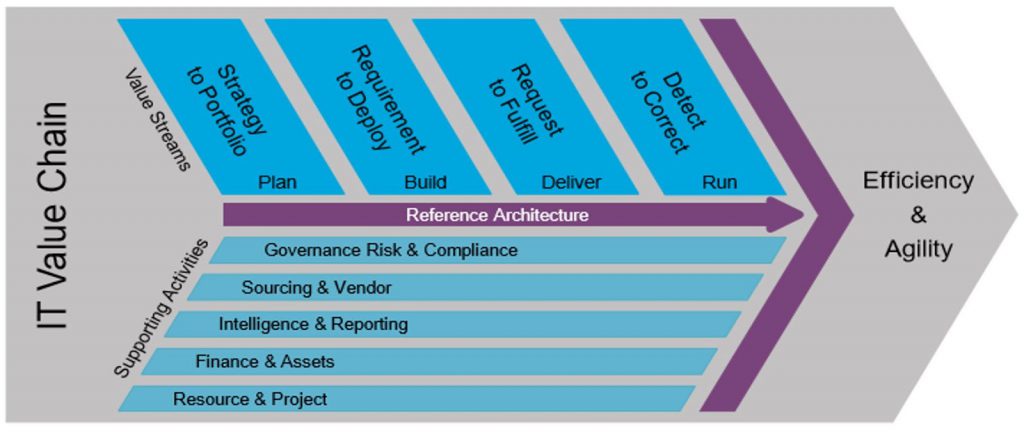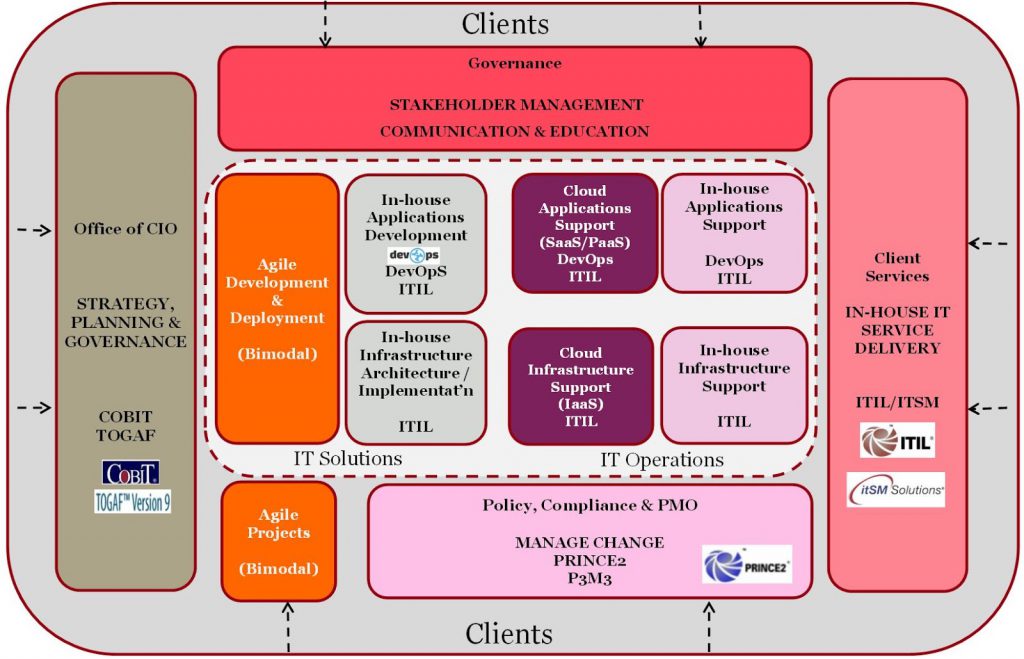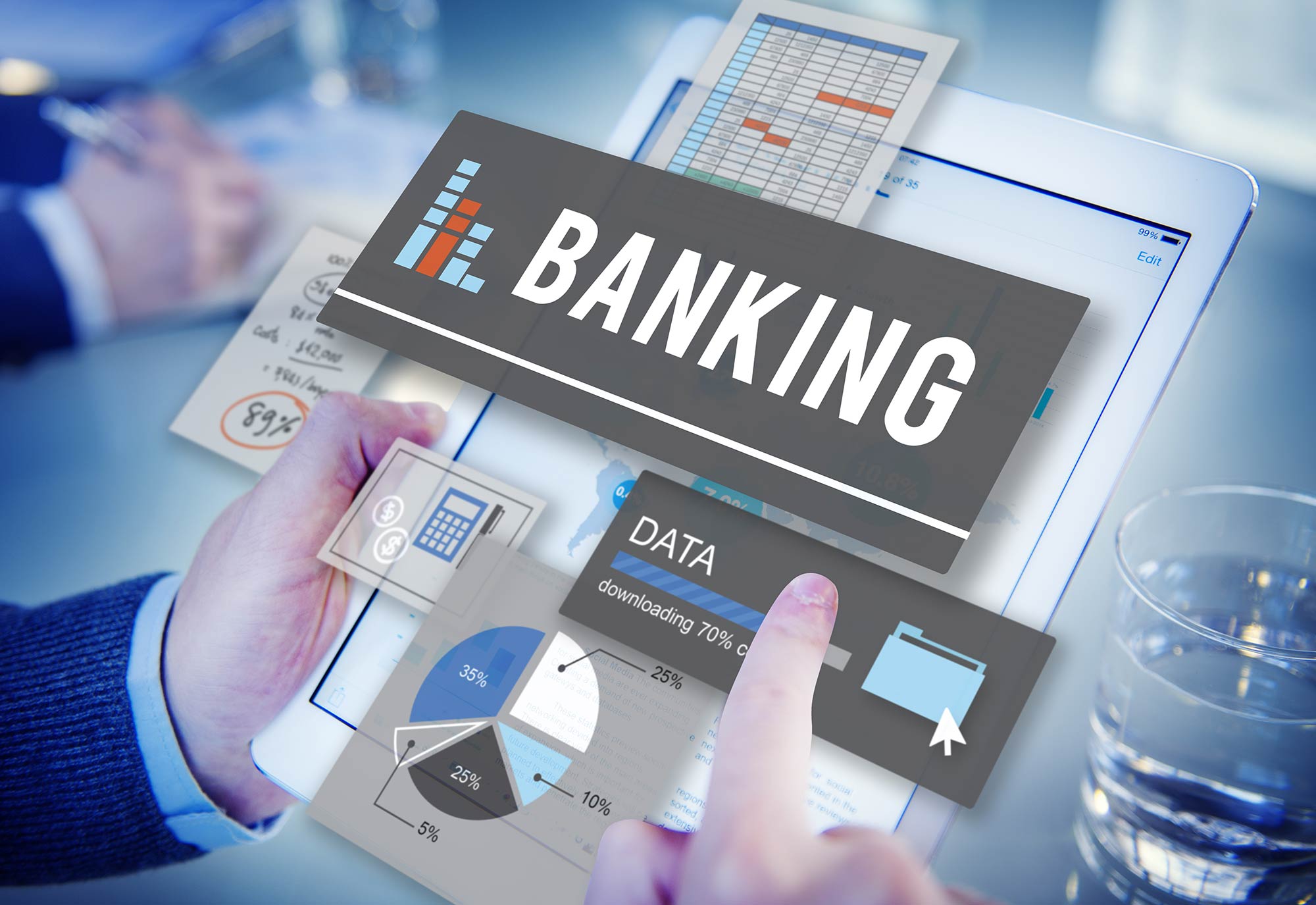
05 Oct MYO IT – Building an IT organisation
Know more of our DIGITAL & ICT STRATEGY capabilities.
Imagine the excitement of starting again, no baggage, and building a new (or improved) IT organisation; Of being able to build the business from the ground up and manage the business of IT properly from the outset. A scenario like this offers immense opportunities but also prompts so many questions:
- Is there a legacy to inherit or is it Greenfield?
- Will we be a service provider? A service broker? A smart buyer? Or a mixture of each?
- Will we do IT ourselves or get someone else to do IT for us? Which bits?
- What will be our customer value proposition? How will we stay relevant?
- Will we be on premise or in the cloud? In full or in part?
- What capabilities will we need? Where are the gaps?
That’s a lot of questions and I’m only scratching the surface! So let’s take the opportunity to explore some of these issues and also some of the tools that might help us answer the questions. We’ll also consider IT operating models and industry frameworks and standards in an attempt to shine some light on the topic.
Contemplating an IT operating model?
When it comes to ICT management there appears to have been recent interest in filling the apparent void of IT standards and practices. For many who thought that the established frameworks such as COBIT® (by ISACA), TOGAF® (by The Open Group) and ITIL® (by Axelos), already filled that void, the news may come as a bit of a shock.
The most notable new kids on the block include IT4ITTM (the recent offering from The Open Group) and Technology Business Management (TBM) headed by the TBM Council. In addition let’s throw into the mix a commercial take on ‘Enabling IT as a Service’ from a major IT service provider.
These new players seem to be concerned mostly with managing the business of IT or running IT as a business. Equally, both seem to be focused on emphasising the value of IT and showcase progressive approaches to IT such as brokering services, cloud, IT as a Service, DevOps etc. Both approaches are also ‘data-driven’ which resonates with me from my days in the eighties with LBMS in London who took a data-driven approach to its SSADM and LSDM development methodologies. Both approaches are agile-friendly.
Whilst other methods and frameworks have introduced standards for many of the processes in IT, (enterprise architecture, strategic alignment and governance, security, applications development, program, portfolio and project management, operations and support etc.), it is fair to say that for too long IT Managers, CIOs and CTOs have been left to link those standards together in the best manner they can. This has revealed some gaps.
Let’s consider the new players
IT4ITTM provides a Standard Reference Architecture for IT. This comprises an IT Value Chain plus service, information, functional and integration pillars. The IT value chain is based on the work of Michael Porter and it comprises four value streams being:
1. Strategy to Portfolio (S2P)
2. Requirements to Deploy (R2D)
3. Request to Fulfil (R2F)
4. Detect to Correct (D2C)

The primary value streams in the IT Value Chain are underpinned by five supporting activities. IT4IT models the functions that IT performs to help organisations identify the activities that contribute to business competitiveness.
Now let’s look at what TBM has to offer. TBM essentially defines the organisational elements, disciplines and value conversations of an effective TBM program.

Its apparent focus is (to a large extent) on the cost and value of IT. This includes:
1. Run the Business
– Cost of Performance
– Business Aligned Portfolio
2. Change the Business
– Investment in innovation
– Enterprise Agility
TBM uses ‘value conversations’ across all of these as well as four core disciplines – Create transparency, Deliver value for money, Shape business demand, and Plan and govern – to help run and change the business. These were certainly second nature to me as an ex-CIO.
Creating an IT operating model
In CISCO’s white paper ‘IT Transformation with Cisco’, they describe ‘Creating an operating model that enables IT as a service’. Email us for a copy of the white paper!
This diagram depicts the ‘Capabilities of a transformed IT organisation’.
Most noticeable is the resemblance between the IT4ITTM Value Chain and the Cisco Capabilities Model above. This suggests some element of synergy, intentionally or otherwise.
So which is the best framework?
To give a practical example it’s worth referring to a presentation on ‘How Shell IT manages data to bend the cost curve’. This is a case study of TBM presented by Shell’s IT4ITTM Team on the TBM Council website. They claim to have achieved a 20% cost reduction in applications run costs. As Shell is one of the principle architects and proponents of IT4ITTM this provides a good indication of how the two approaches might complement each other.
It is most likely that IT4ITTM represents a more extensive and comprehensive IT Management framework whereas TBM offers a richer coverage of specific features and disciplines. The latter would appear to be particularly true in relation to cost containment, business value and portfolio management. COBIT® v5 combined with Val IT (Business Value of IT) clearly offers additional perspective on those topics covered by TBM.
The short answer is to apply the best horse to suit the course you’ve set about travelling. If you’re specifically looking at cost containment or value management initiatives then the best short term approach will most likely involve TBM. If on the other hand what you crave is end to end IT service management and execution, then IT4ITTM would provide a more prescriptive platform.
Although these frameworks have been around (at least in part) over a few years, this does make them relatively immature when compared with COBIT® (v5) and TOGAF® (V9.1). At the same time, both IT4ITTM and TBM are heavily supported (and developed) by a range of significant industry leaders. Hence they are worthy of significant attention. In an industry that has long suffered the consequences of inadequate standards, it is reassuring to know that we (IT Professionals) may finally be headed towards the same standing that is enjoyed by the likes of HR and Finance practitioners.
IT operating model and organisation structure
The following diagram is an example of another IT operating model. It was designed for a client to respond to the internal and external drivers in their industry.
It generally reflects similar elements to the Cisco model, that is, strategy and planning, governance, IT solutions (i.e. service design and development), IT operations and client services (i.e. support). In addition, its features include Agile Development, Bimodal IT, I/S/PaaS and DevOps. Various frameworks and methodologies have been overlayed including COBIT®, TOGAF®, ITIL® and Prince2 (by Axelos).
It’s also worth introducing Gartner’s IS Lite and IS Lean models at this stage:
Over many years I have applied Gartner’s Lite and Lean models to assist in identifying the most appropriate allocation of capabilities to both in-house and outsourced IT organisations. This knowledge is a critical ingredient in building effective and efficient IT business models and structures.
With all of these models available, the task of designing an appropriate business model for your organisations should be relatively straight forward.
What’s the final step?
Moving from business model, through macro and then micro structure design, is the last step before such things as job specifications, recruitment and so on. The challenge is to try to maintain the integrity of the underlying business model when building the structure. For example, a structure based upon the four IT4ITTM value streams might well be considered. However, an alternative functional structure might better suit the particular circumstances. The level of IT4ITTM maturity may also be a factor.
So what can we take away from this?
In order to build your IT organisation (MYO IT) you need to:
1. Understand the internal and external drivers for your IT business.
2. Contemplate your customer value proposition.
3. Initiate a change management process.
4. Identify your target capability profile and any gaps (See Gartner’s IS Lite and IS Lean).
5. Design your IT operating model (see IT4ITTM, TBM, Cisco and Client models).
6. Design your macro and micro organisation structure.
7. Complete role descriptions, sizing etc.
8. Build your core IT team.
9. Procure your partners.
10. Complete the change management process.
Now you’re ready to start!
- Tech Your Business Podcast - 26 February 2024
- Security Market Watch Podcast - 26 February 2024
- The Business Octopus Podcast - 15 February 2024















